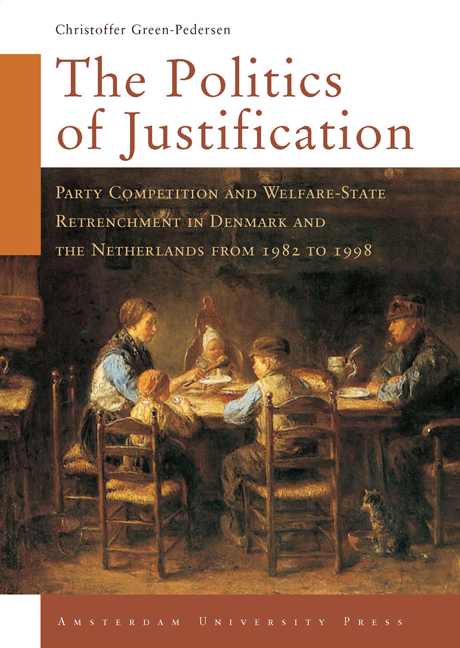 The Politics of Justification
The Politics of Justification Book contents
- Frontmatter
- Acknowledgments
- Contents
- List of Abbreviations
- 1 Introduction
- 2 From Theories of Expansion to Theories of Retrenchment
- 3 Framework for Government Choice on Retrenchment
- 4 Research Strategy and Research Design
- 5 Retrenchments in Denmark and the Netherlands
- 6 Dutch Politics and Welfare-State Retrenchment.How Party Competition Produced Consensus
- 7 Danish Politics and Welfare-State Retrenchment:The Difficulties of a Right-Wing Government and the Possibilities of a Left-Wing Government
- 8 The Evidence on Balance and some Quibbles
- 9 Party Politics Matter – Summary and Implications
- Appendix
- Summary
- Notes
- References
- Index
4 - Research Strategy and Research Design
Published online by Cambridge University Press: 15 January 2021
- Frontmatter
- Acknowledgments
- Contents
- List of Abbreviations
- 1 Introduction
- 2 From Theories of Expansion to Theories of Retrenchment
- 3 Framework for Government Choice on Retrenchment
- 4 Research Strategy and Research Design
- 5 Retrenchments in Denmark and the Netherlands
- 6 Dutch Politics and Welfare-State Retrenchment.How Party Competition Produced Consensus
- 7 Danish Politics and Welfare-State Retrenchment:The Difficulties of a Right-Wing Government and the Possibilities of a Left-Wing Government
- 8 The Evidence on Balance and some Quibbles
- 9 Party Politics Matter – Summary and Implications
- Appendix
- Summary
- Notes
- References
- Index
Summary
The aim of this chapter is to present the research strategy and research design of the study. As will be further explained below, the overall research strategy of this study is comparable case studies. The chapter therefore starts with a discussion of the choice of cases. This includes both the choice of countries, social-security programmes, and time period. The chapter then goes on to discuss the definition and measurement of the dependent variable, namely retrenchment. The overall aim of the empirical parts of the study is to determine whether or not there is empirical support for the theoretical framework developed in chapter 3. Following King, Keohane & Verba (1994), the best way to investigate the explanatory power of a framework is to derive as many empirically observable implications or empirical hypotheses from it as possible and to see whether these match the actual empirical developments. Therefore, this chapter ends by developing 6 hypotheses about variation in retrenchment across the selected cases.
Denmark and the Netherlands – a most similar systems design
Starting with the country level, the study is based on a most similar systems design (Lijphart 1971; Frendreis 1983). This implies that the two ideal cases for this study would be two countries representing the two different modes of party competition discussed in chapter 3, while at the same time being similar in all other relevant respects. The relevant respects with regard to this study are the institutional and economic factors discussed in chapter 2. Two such ideal countries do not exist. However, as will be argued below, Denmark and the Netherlands are fairly close and have been investigated.
As will be further argued in chapters 6 and 7, the two countries exemplify the two different modes of party competition. Denmark represents the bloc type of party competition. It is either governed by social democratic governments, often including one or several small centre parties, or right-wing governments, mostly involving both the two major right-wing parties, the Conservatives and the Liberals (Damgaard 1992). The Netherlands represents the pivotal type of party competition. The pivotal party is the Christian Democratic Party or cda.
- Type
- Chapter
- Information
- The Politics of JustificationParty Competition and Welfare-State Retrenchment in Denmark and the Netherlands from 1982 to 1998, pp. 43 - 64Publisher: Amsterdam University PressPrint publication year: 2002
